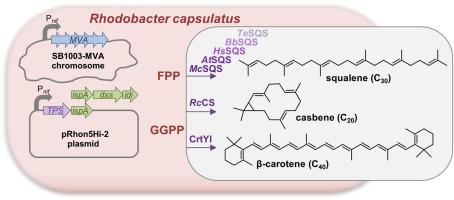Journal of Biotechnology ( IF 4.1 ) Pub Date : 2021-07-05 , DOI: 10.1016/j.jbiotec.2021.07.002 Jennifer Hage-Hülsmann 1 , Oliver Klaus 2 , Karl Linke 2 , Katrin Troost 2 , Lukas Gora 2 , Fabienne Hilgers 3 , Astrid Wirtz 4 , Beatrix Santiago-Schübel 5 , Anita Loeschcke 6 , Karl-Erich Jaeger 7 , Thomas Drepper 6

|
Terpenes constitute one of the largest groups of secondary metabolites that are used, for example, as food-additives, fragrances or pharmaceuticals. Due to the formation of an intracytoplasmic membrane system and an efficient intrinsic tetraterpene pathway, the phototrophic α-proteobacterium Rhodobacter capsulatus offers favorable properties for the production of hydrophobic terpenes. However, research efforts have largely focused on sesquiterpene production. Recently, we have developed modular tools allowing to engineer the biosynthesis of terpene precursors. These tools were now applied to boost the biosynthesis of the diterpene casbene, the triterpene squalene and the tetraterpene β-carotene in R. capsulatus SB1003. Selected enzymes of the intrinsic isoprenoid pathway and the heterologous mevalonate (MVA) pathway were co-expressed together with the respective terpene synthases in various combinations. Remarkably, co-expression of genes ispA, idi and dxs enhanced the synthesis of casbene and β-carotene. In contrast, co-expression of precursor biosynthetic genes with the squalene synthase from Arabidopsis thaliana reduced squalene titers. Therefore, we further employed four alternative pro- and eukaryotic squalene synthases. Here, the synthase from Methylococcus capsulatus enabled highest product levels of 90 mg/L squalene upon co-expression with ispA. In summary, we demonstrate the applicability of R. capsulatus for the heterologous production of diverse terpene classes and provide relevant insights for further development of such platforms.
中文翻译:

在工程光养细菌荚膜红杆菌中生产 C20、C30 和 C40 萜
萜烯是最大的次级代谢产物之一,例如用作食品添加剂、香料或药物。由于胞质内膜系统的形成和有效的内在四萜途径,光养α-变形杆菌荚膜红杆菌为疏水萜烯的生产提供了有利的特性。然而,研究工作主要集中在倍半萜烯的生产上。最近,我们开发了模块化工具,可以设计萜烯前体的生物合成。这些工具现在用于促进R. capsulatus 中二萜卡宾、三萜角鲨烯和四萜 β-胡萝卜素的生物合成SB1003。内源性类异戊二烯途径和异源甲羟戊酸 (MVA) 途径的选定酶与各自的萜烯合酶以各种组合共表达。值得注意的是,基因ispA、idi和dxs 的共表达增强了 casbene 和 β-胡萝卜素的合成。相比之下,前体生物合成基因与来自拟南芥的角鲨烯合酶的共表达降低了角鲨烯滴度。因此,我们进一步采用了四种替代的原核和真核角鲨烯合酶。这里,从合酶甲基球菌荚膜在用共表达使90毫克/升的角鲨烯最高产物水平ISPA. 总之,我们证明了R. capsulatus对不同萜类异源生产的适用性,并为此类平台的进一步开发提供了相关见解。



























 京公网安备 11010802027423号
京公网安备 11010802027423号